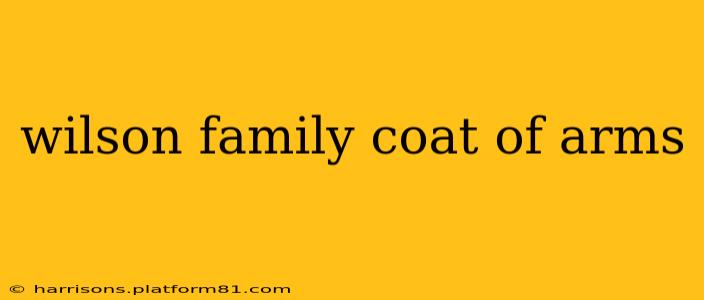The Wilson surname, a prominent one globally, boasts a rich tapestry of history and, consequently, a multitude of potential coats of arms. Unlike a single, universally recognized crest for all Wilsons, the reality is far more nuanced. Understanding the Wilson family coat of arms requires delving into the intricacies of heraldic tradition and genealogical research. This exploration will demystify the process and help you understand how to trace your own family's potential heraldic connections.
What is a Coat of Arms?
Before we delve into specific Wilson coats of arms, it's vital to understand the fundamental principles of heraldry. A coat of arms is a unique emblem, often displayed on a shield, that historically signified lineage, family status, and achievements. These designs weren't arbitrarily chosen; they were carefully constructed and granted by official heralds, often reflecting the family's history, values, and geographical origins. The design elements – colors, symbols, and charges – all carry symbolic meaning.
Are There Multiple Wilson Coats of Arms?
Yes, absolutely. There's no single "Wilson" coat of arms. The surname Wilson is geographically widespread, originating in different places and evolving through various branches over centuries. Each family, over time, might have been granted, or adopted, its own unique coat of arms. The prevalence of the name, combined with the granting of arms in different regions over centuries, means a wide array of designs exists associated with the Wilson name.
How Can I Find My Wilson Family Coat of Arms?
Discovering your family's specific coat of arms, if one exists, requires genealogical research. This involves tracing your ancestry back to determine where your ancestors originally hailed from and whether they were granted a coat of arms. This is not a quick process; it may involve meticulous research through:
- Genealogical Records: Parish records, census data, land deeds, and wills can help trace your family tree and pinpoint geographical origins. This is crucial as it will help narrow down your search for the relevant heraldry.
- Heraldry Databases: There are numerous online and offline databases dedicated to heraldry. These databases can be searched for specific family names and locations, though they often require subscriptions or access fees. Always verify information found in these resources through additional independent research.
- Professional Genealogists and Heralds: If your research proves challenging, consider enlisting the help of professional genealogists or heraldic experts. They possess the skills and resources to navigate complex family histories and official heraldic records.
What Does a Wilson Coat of Arms Look Like? (Examples are not provided due to copyright restrictions and the wide variety of existing arms)
It's impossible to display specific examples of Wilson coats of arms here without infringing upon copyright and potentially misrepresenting the ownership of such images. Many websites displaying coats of arms often lack the necessary provenance or are inaccurate. Always verify any claimed Wilson coat of arms through rigorous genealogical research and reputable heraldic sources.
What if My Family Doesn't Have a Recorded Coat of Arms?
Many families, even prominent ones, might lack documented coats of arms. The granting of arms was often associated with specific achievements or social standing, and many families may not have met the criteria or sought the process. The absence of a documented coat of arms doesn't diminish the richness of your family history.
Can I Create My Own Wilson Coat of Arms?
No. The creation and use of coats of arms are strictly regulated. Creating your own coat of arms would constitute a form of heraldic fraud. Authentic coats of arms are historically granted and are subject to stringent rules concerning design and usage.
By understanding the complexities of heraldic tradition and engaging in meticulous genealogical research, you can embark on a rewarding journey towards uncovering the fascinating history of your own Wilson family and the potential coats of arms that may be associated with your lineage. Remember to approach this process with patience, accuracy, and a respect for the historical and cultural significance of heraldry.
